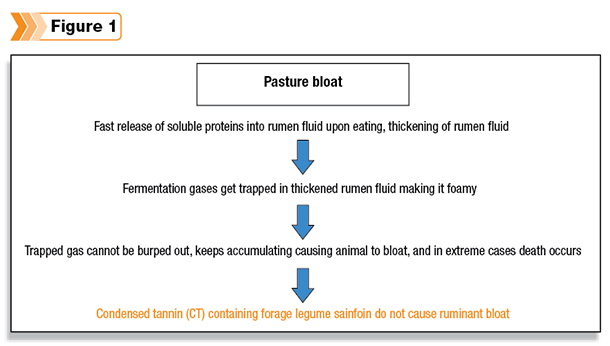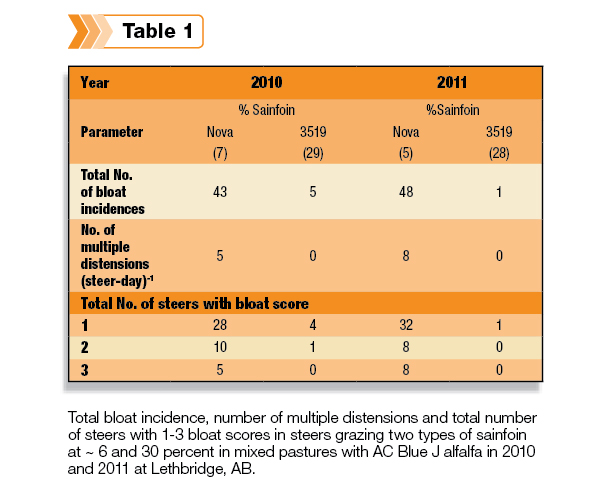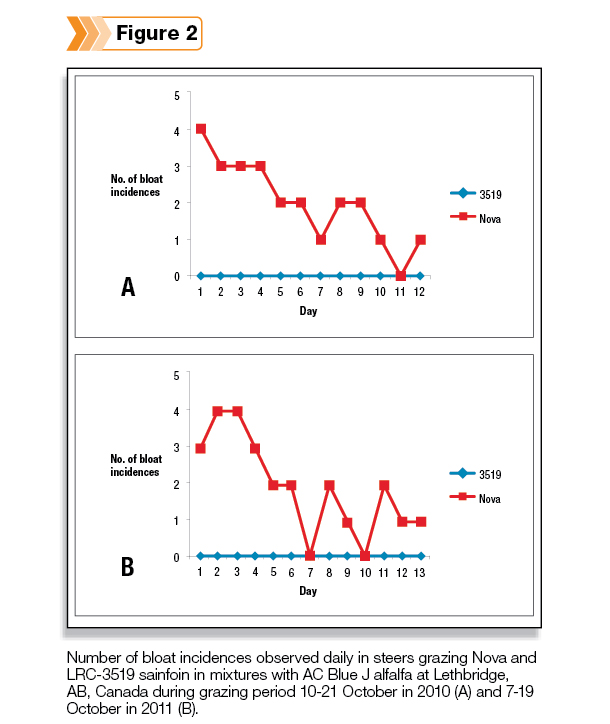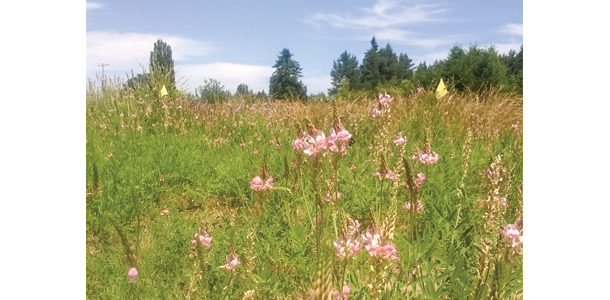Beef cattle weight gains on alfalfa pastures under proper management are comparable to those achieved in confined feedlot systems.
Live weight gains of 2.2 to 3.3 pounds (1 to 1.5 kg) per day and gains of 392 to 731 pounds per acre (440 to 820 kg per hectare) have been reported for steers grazing alfalfa. However, the risk of frothy bloat is a major deterrent to the grazing of pure alfalfa pastures.
Understanding bloat
The protein in alfalfa is rapidly fermented in the rumen and this contributes to the formation of stable foam that is indicative of pasture bloat (Figure 1).
Naturally occurring condensed tannin (CT) in sainfoin binds to proteins in a pH-dependent/reversible manner, reducing the formation of stable foam and the incidence of bloat in ruminants.
This CT binding process also improves the nutritional value of forage protein and has been reported to improve milk production in grazing ewes and dairy cows fed fresh forage.
It is well known that about 10 to 15 percent of sainfoin dry matter fed as hay, pellets or fresh herbage in a fresh alfalfa diet was sufficient to reduce bloat incidence by 45 to 93 percent in steers fed in pens.
However, the problem with existing sainfoin cultivars is their poor persistence under grazing and in mixtures with alfalfa. The present cultivars also have poor re-growth after grazing, making the mixed stands vulnerable to bloat.
At the Lethbridge Research Centre (LRC), selections were made for improved performance in mixed alfalfa-sainfoin stands under a multiple-cut management.
Some of these new sainfoin populations have been observed to persist better in mixed alfalfa stands in western Canada and re-grow after cutting or grazing better than Nova sainfoin, which was licensed for sale in Canada in 1980. However, to be useful in alfalfa pasture their bloat-reduction/prevention properties needed to be evaluated.
The new LRC-3519 sainfoin
Our working hypothesis was that the new populations developed through selection for a multiple-cut system and tested for improved performance in mixed stands would persist better in mixtures with alfalfa than the cultivar Nova and thus reduce pasture bloat in cattle grazing alfalfa-sainfoin mixed stands. (Nova was used for comparison as this cultivar is used for commercial production in Canada, and presently is the check cultivar in western Canada.)
For this purpose, alfalfa-sainfoin mixed pastures established in 2008 at Lethbridge were used. The two mixed pasture treatments consisted of the cultivar Nova and a newly developed sainfoin population LRC-3519 with a high-yielding AC Blue J (BJ) alfalfa in alternate rows.
Seeding rate for alfalfa and sainfoin were adjusted to produce 50-50 proportions of the two components on a dry matter basis.
Prior to the bloat studies in 2010 and 2011, the pastures were rotationally grazed twice using steers. To maximize bloat occurrence, this study was carried out Sept. 29 to Oct. 21, 2010, and Sept. 26 to Oct. 19, 2011, on the second re-growth of the pastures when both alfalfa and sainfoin were in vegetative stage.
The mean proportions of sainfoin (on a dry matter basis) in the pastures were 7 and 29 percent in 2010, and 5 and 28 percent in 2011 for Nova and LRC-3519, respectively.
The bloat study
Pasture bloat was assessed using 10 615-pound Angus steers (± 80 pounds, or 615 ± 36 kg) fitted with ruminal cannulae. The steers were adapted in a separate alfalfa-sainfoin mixed pasture for seven days prior to the start of the experiment.
Steers were randomly divided into two groups of five and assigned to two treatments in a crossover design, with each group being exposed to both treatments.
To ensure daily exposure to fresh pasture, plots were further subdivided into small paddocks using electric fence, and each paddock was grazed for one day only.
The steers grazed the pastures for six hours per day from 8 a.m. to 2 p.m., and then were held in a fenced area with access to only water, no feed. This management approach is known to maximize the risk of bloat in cattle grazing alfalfa.
The steers were observed and scored for bloat using visual scoring of 0 to 3: Scores 1 and 2 were classified as subacute bloat and 3 as acute bloat. Any steer with a bloat score of 3 was haltered and its cannula opened to relieve pressure. Multiple bloats on the same day by the same animal were considered as one case of bloat, although the number of distensions per animal-day was recorded.
The results
In 2010, the total number of steers experiencing bloat was about 90 percent (43 out of 48 total bloat incidences) in Nova-alfalfa mixed pastures – a level that was significantly higher than in LRC-3519/alfalfa pastures, which had only 10 percent of the incidences (five out of 48). The highest bloat score (severity) recorded on Nova-alfalfa plots was 3, which was an acute form of frothy bloat, while the highest score on LRC-3519/alfalfa plots was 2.
In 2011, 98 percent of the recorded bloat incidences in all steers occurred in those grazing Nova-alfalfa plots with the highest severity being 3, compared to a bloat incidence of 2 percent in steers grazing LRC-3519/alfalfa, with the severity score not exceeding 1 in this treatment (Table 1 and Figure 2).
Summary
This study suggested that the new sainfoin populations, capable of providing 25 to 30 percent biomass for three years, can be used to reduce the risk of bloat in cattle grazing alfalfa pastures even though steers appeared to prefer alfalfa (55 percent) to sainfoin (45 percent) if both are available.
This new sainfoin cultivar is truly one of a kind and represents an exciting new opportunity for cattle producers. It is the first sainfoin cultivar that will survive in alfalfa pasture and grow back at the same rate after cutting or grazing.
It will prevent bloat in mixed stands to provide producers with their first real, economically viable option to allow for highly productive, bloat-free alfalfa pasture grazing.











